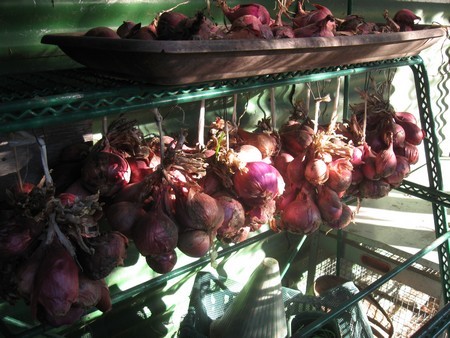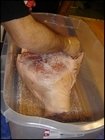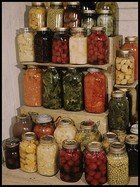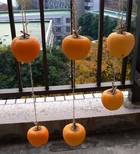Preserving Food at Home: Freezing, Drying, Salting, Smoking, Pickling
Before freezers and refrigerators were around the only way to preserve food was to salt, smoke, bottle, store live or air-dry. These methods are still used today, in conjunction with our freezers and fridges that are handy to have when preserving food.
Why do we need to Preserve Food?
By preserving food we not only retard the spoiling process but we also maintain the texture and the flavor. And we can only do this if we choose the correct method of food preservation with the right containers to safe guard against bacteria and other harmful organisms.
The key to good food preservation is cleanliness. This means clean hands, clean surfaces, clean utensils and clean bottles, if used. Also your produce should be fresh and at its prime. It should not be at the point where it is starting to spoil or deteriorate.
There are several methods of food preservation, the most common we will discuss here.
Preserving Food by Salting and Air Drying
One of the oldest methods of food preservation is salting and air drying. The pioneers used this method to dry meat. In South Africa it is called biltong, in Australia and America it is called jerky. Fish was another food that was dried this way, as is today's pork in the form of Prosciutto. Drying food like this was done because when people traveled long distances they weren't sure when next they would get another supply of meat or fish, and this was one way of making sure that they had a steady supply of protein. Curing ham can be done at home with these instructions.Preserving Food by Live Storage
The early ripening apples and pears do not store well, and should just be eaten as they appear. However, the late-ripening varieties are worth storing. Leave on the trees until well ripe, but not blemished. Remove and allow to dry in a single layer overnight. The next morning, wrap individually in paper and store in a dark place.
Potatoes can be successfully stored by storing with straw. Take a large wooden box, place a layer of straw and then fill with potatoes or any other root vegetable to a depth of about a foot. Cover again with straw. Continue in this way until all your vegetables are stored. Cover with a stout lid that will allow air in, but keep rats out.

Onions can be preserved by stringing them, or lying them on slats. Before they are stored they must be thoroughly dried first. When stringing onions start with 4 onions with long stalks. Tie them together and then tie on a long length of twine or bailing string. Add each additional onion to the bunch making sure that the stalks are well secured and plaiting the knotted stalks around the end of the bailing string so that the onions hang evenly when you hold them up. Onions strung like this will keep indefinitely.
An old way of preserving food using live storage is clamping. This is when vegetables like potatoes are lifted and allowed to dry for 2-3 hours. Then they are placed on a thick bed of stray and placed carefully in a triangle shape. More straw is used to cover the potatoes where a couple of days are given to allow the potatoes to finish sweating. After they have stopped sweating the potatoes are then covered with soil, 5-6 inches deep. Allow some of the straw to be seen protruding from the soil so that the vegetables can still breathe.
Apples, carrots, cabbages, onions, parsnips, pears, potatoes, pumpkins, radishes and turnips can all be stored and preserved in this way.
Preserving Food by Freezing
If food is stored in a freezer at -18° C it will keep well for at least 6 months. Freezing meat and freezing vegetables are two ways we can preserve our food. Vegetables can be blanched first and then frozen. Some fruit can also be preserved in this way. Meat and fish can also be frozen, but they do have a shelf-life. Fish should not be frozen for more than 3 months, and meat should not be frozen more than 6 months.Meat should be well-wrapped because if it comes into contact with the cold air inside your deep-freeze the meat will spoil and get freezer-burnt.
Apples, apricots, asparagus, beans, blackberries, broccoli, Brussels sprouts, capsicums, carrots, cauliflower, celery, cherries, citrus fruit, corn, figs, grapes, nectarines, parsnips, passion fruit, peaches, peas, pineapples, plums, raspberries, rhubarb, spinach, and tomatoes can all be frozen.
Preserving Food by Canning and Bottling
Ideal bottling conditions are being able to place your bottled produce in a dark room in order to prevent vitamin loss and at a temperature below 18° C.
Apples, apricots, beets, blackberries, capsicums, cherries, citrus fruit, figs, grapes, mulberries, nectarines, passion fruit, peaches, pineapples, plums, raspberries, rhubarb and tomatoes can all be preserved by this method.
Preserving Food by Pickling
Many foods can be preserved with pickling and making your own pickles. The effect of the pickling liquids on both fruits and vegetables in your pickle recipes is very similar. The salt in the brine or the vinegar hardens the cellulose of the foods to such an extent that they are impervious to the action of bacteria. While this permits the foods to keep well, it also makes them difficult to digest, a fact that must be remembered when pickled foods are included in the diet.Apples, beans, beets, cucumbers, mushrooms, onions, pears, tomatoes walnuts, and watermelon are just some of the fruits and vegetables that can be preserved by this method.
Preserving Food by Jams and Jellies
Making jams and jellies out of excess fruit is another food preserving method. The addition of sugar and the evaporation of water in the process allows for the fruit to be successfully preserved.Apples, blackberries, apricots, cherries, citrus fruits, figs, grapes, mangoes, mulberries, passion fruit, peaches, pears, pineapples, plums, raspberries, and rhubarb can all be preserved using this method.
Preserving Food by Drying
Drying fruits such as tomatoes, peaches, grapes, apricots and prunes can either be done naturally using the sun or dried using a slow oven. Reducing the water content of the fruit reduces the chance of bacteria growing. Although food drying has been done for centuries the vitamin content of the food dried this way is often compromised. Firstly, Vitamins A, E and some B-complex Vitamins are lost if the food is dried in full sunlight. Secondly, Vitamins A, C, and E is lost through the oxidation process when stored for any length of time.To dry apples, core them, slice them, string up the slices and hang them over a stove or in a solar-heated drier for 5 hours at 65° C. When crisp and dry put them in an airtight container.
Preserving Food by Smoking
Finally, we conclude this article on preserving food using methods of smoking. This is very successful using fish and meats. You don't actually need a fancy smoker to smoke your fish or meat. If you have a fireplace that you use every night, then you can make good use of the chimney. Hang the meat high up in the chimney so that it is out of the way of the fire, and leave it there for about a week, making sure that the wood fire doesn't go out during that period of time.If you want to build a smoker there are two methods of smoking meat, one is a cold smoking method, and the other is a cooked-smoking method that is more common in America and Germany.
With the cooked-smoking method the meat is smoked at high temperatures from 65 - 93° C. Here, due to the high temperatures, the meat is cooked and smoked at the same time. Meat cooked this way has to be eaten fairly shortly after production, unlike the cold smoking method that allows one to keep the meat a little longer.
For those of you who would like to smoke your own meat, smokehouses can be built or devised out of barrels and charcoal cookers. If you are wanting a concrete smokehouse and looking for smokehouse plans then look no further.
Books on Preserving Food
You can Add your own Ideas on Preserving Food Here!
We have lots of pages where you can contribute to throughout this homesteading website. We love hearing from our readers, and hope you will be one of those we hear from too. Look around our homesteading website. If you have any tips, advice or additional information that you would like to share on preserving food, please send it in! All you need to do is type and we will do the rest.
Leave a Comment
Do you have anything that you would like to add after reading this page? We would love to hear your thoughts. If you can add additional information to what has been written here you will be adding value to the website! No need to have any special skills - just type and submit. We will do the rest!
Other Comments
Click below to see comments from other visitors to this page...
Food Preserving Not rated yet
What is the exact time to preserve food?
Please answer.
*****
Kimberley, your post is very vague because you can preserve food in a number …
Best method for preserving nutrients in food Not rated yet
Hi all,
Thanks for this website. It makes a lot of sense to return to living with and off the land-- not against the land!
I am new to food preservation, …








New! Comments
Do you have something of value to add? Leave me a comment in the box below.